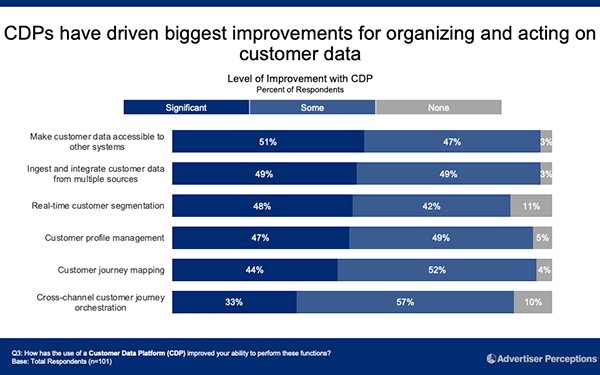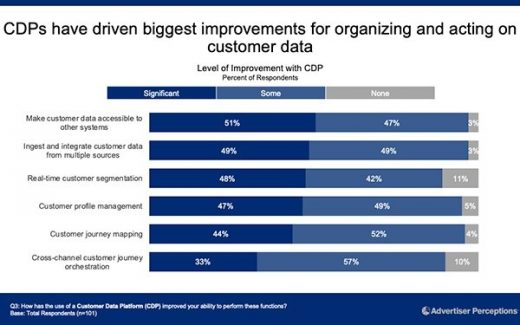Customer Data Platforms Take On Bigger Role As Cookies Disappear, Privacy Compliance Tightens
Customer Data Platforms Take On Bigger Role As Cookies Disappear, Privacy Compliance Tightens

With the state of third-party cookies and identifiers in flux, as well as increasing regulations around consumer privacy, Customer Data Platforms (CDPs) that can combine first-, second- and third-party data have become the latest tool in the chest for marketers.
Research from Advertiser Perceptions shows marketers generally view CDPs as an important part of their privacy compliance efforts. A sample of 101 respondents were surveyed between July 27 and August 17 to determine their views on CDPs.
For the study, Advertiser Perceptions focused on marketers from U.S.-based companies with at least $500 million in annual revenue.
CDPs impact on success metrics varies. Some 45% of marketers said CDPs have the most significant impact on online sales, while 43% pointed to return on investments and return on ad spend, 41% cited engagement, 41% cited cross-selling, 39% cited cost per action, and 38% cited brand lift. Conversion rate, Customer acquisition, and reduced shopping cart abandonment also came in with a score of 38%.
Companies are using CDPs for a variety of reasons. Marketers are integrating their CDPs with other marketing technologies to personalize communications and improve customer experience and customer journeys. They also apply CDP insights to their ad campaigns to personalize advertising campaigns in real-time, or target specific customer segments.
Internally, marketers use CDPs to better understand various customer IDs and customer-specific insights across the organization that can be fed to other appropriate teams as needed.
While both house customer data, CPDs differ from CRMs.
CRMs can organize different types of customer data, but CDPs can activate that data across the marketing and advertising ecosystem, Stuart Schneiderman, SVP and business intelligence at Advertiser Perceptions, explains in an email to Search & Performance Marketing Daily.
“CDPs pull in CRM and transactional data,” he wrote. “They go beyond by integrating varied sources such as first- and third-party data, mobile, social, web site analytics and product usage data.”
Whereas CRMs limit the information to known data about customers, CDPs use known and anonymous data to create unified views of customers.
CRMs tend to be focused on managing sales and sales pipelines. CDPs go beyond that to implement, manage and optimize advertising and marketing programs that can be aligned to customer journeys.
When survey participants were asked to name the types of data they currently merge or unify with their CDP, 76% said they currently merge CRM data.
Some 65% cited transactional data, while 57% pointed to website visits, 49% cited customer support data, 47% cited first-party customer profile data, 46% use mobile and device-level data, 46% use product use data, and 45% use third-party data. Other types of data cited include social media, anonymized from cookies, app data, and offline data.
CDPs also have a major privacy compliance role, helping marketers as they address challenges and respond to regulations, according to the findings.
About 66% build GDPR and CCPA compliance marketing lists using the data, while 63% centralize and unify customer data, 55% manage compliance programs, 52% enforce opt-out policies, 52% increase transparency around data use, and 52% enforce data retention and use policies.
Other strategies include conducting data audits to validate the types of information collected, enforce the right to be forgotten, and restrict access and rights management to select areas of the organization.
(17)


